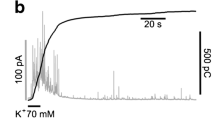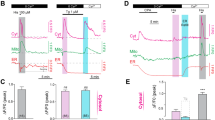Abstract
We demonstrate that the application of the muscarinic agonist carbachol to the human salivary epithelial cell line HSG elicits the now well-known phenomenon of ‘quantal’ Ca2+-release; namely, that the application of a submaximal concentration of agonist results in the release of only a portion of the agonist-sensitive intracellular Ca2+ pool. One explanation that has been proposed to account for this effect is that there are multiple intracellular Ca2+ stores, each with a different agonist sensitivity, which release Ca2+ in an ‘all-or-none’ fashion. We test this hypothesis in intact HSG cells with an experimental protocol designed to preferentially load less-agonist-sensitive stores with 45Ca2+ and more-agonist-sensitive stores with 45Ca2+. However, contrary to the expectations of the above explanation, these cells do not preferentially release 45Ca2+ in response to low concentrations of agonist. Thus our data suggest that quantal Ca2+ release must arise from some other property of the stores or their Ca2+ release channels.
Similar content being viewed by others
References
Berridge MJ: Inositol trisphosphate and calcium signalling. Nature 361: 315, 1993
Ferris CD, Snyder SH: Inositol 1,4,5-trisphosphate-activated calcium channels. Annu Rev Physiol 54: 469, 1992
Muallem S, Pandol SJ, Beeker TG: Hormone-evoked calcium release from intracellular stores is a quantal process. J Biol Chem 264: 205, 1989
Missiaen L, Parys JB, De Smedt H, Oike M, Casteels R: Partial calcium release in response to submaximal inositol 1,4,5-trisphosphate receptor activation. Mol Cell Endocrinology 98: 147, 1994
Bootman MD: Quantal Ca2+ release from InsP3-sensitive intracellular Ca2+ stores. Mol Cell Endocrinology 98: 157, 1994
Irvine RF: ‘Quantal’ Ca2+ release and the control of Ca2+ entry by Inositol phosphates—a possible mechanism. FEBS Lett 263: 5, 1990
Shuttleworth TJ: Ca2+ from Inositol trisphosphate-sensitive stores is not modulated by intraluminal [Ca2+]. J Biol Chem 267: 3573, 1992
Nunn DL, Taylor CW: Luminal Ca2+ increases the sensitivity of Ca2− stores to inositol 1,4,5-trisphosphate. Mol Pharmacol 41: 115, 1992
Combettes L, Claret M, Champeil P: Do submaximal InsP3 concentrations only induce the partial discharge of permeabilized hepatocyte calcium pools because of the concomitant reduction of intraluminal Ca2− concentration. FEBS Lett 301: 287, 1992
Parys JB, Missiaen L, De Smedt H, Casteels R: Loading dependence of inositol 1,4,5-trisphosphate-induced Ca2+ release in the clonal cell line A7r5. J Biol Chem 268: 25206, 1993
Missiaen L, De Smedt H, Droogmans G, Casteels R: Luminal Ca2+ controls the activation of the inositol 1,4,5-trisphosphate receptor by cytosolic Ca2+. J Biol Chem 267: 22961, 1992
He X, Wu X, Wellner RB, Baum BJ: Muscarinic receptor regulation of Ca2+ mobilization in a human salivary cell line. Pflugers Arch 413: 505, 1989
He X, Wu X, Turner RJ & Baum BJ: Evidence for two modes of Ca2+ entry following muscarinic stimulation of a human salivary epithelial cell line. J Membrane Biol 115: 159, 1990
Oldershaw KA, Nunn DL & Taylor CW: Quantal Ca2+ mobilization stimulated by inositol 1,4,5-trisphosphate in permeabilized hepatocytes. Biochem J 278: 705, 1991
Missiaen L, De Smedt H, Droogmans G, Casteels R: Ca2+ release induced by Inositol 1,4,5-trisphosphate is a steady-state phenomenon controlled by luminal Ca2+ in permeabilized cells. Nature 357: 599, 1992
Bird GSJ, Obie JF, Putney JW: Functional homogeneity of the nonmitochondrial Ca2+ pool in intact mouse lacrimal acinar cells. J Biol Chem 267: 18382, 1992
Renard-Rooney DC, HaUnoczky G, Seitz MB, Schneider TG, Thomas AP: Imaging of inositol 1,4,5-trisphosphate-induced Ca2+ fluxes in single permeabilized hepatocytes. J Biol Chem 268: 23601, 1993
Short AD, Klein MG, Schneider MF, Gill DL: Inositol 1,4,5-trisphosphate-mediated quantal Ca2+ release measured by high resolution imaging of Ca2+ within organelles. J Biol of Chem 268: 25887, 1993
HaJnoczky G, Lin C, Thomas AP: Luminal communication between intracellular calcium stores modulated by GTP and the cytoskeleton. J Biol Chem 269: 10280, 1994
Author information
Authors and Affiliations
Rights and permissions
About this article
Cite this article
Moran, A., Turner, R.J. Evidence that quantal Ca2+ release in HSG cells is not due to ‘all-or-none’ release from discrete Ca2+ stores with differing sensitivities to IP3. Mol Cell Biochem 158, 53–56 (1996). https://doi.org/10.1007/BF00225882
Received:
Accepted:
Published:
Issue Date:
DOI: https://doi.org/10.1007/BF00225882




